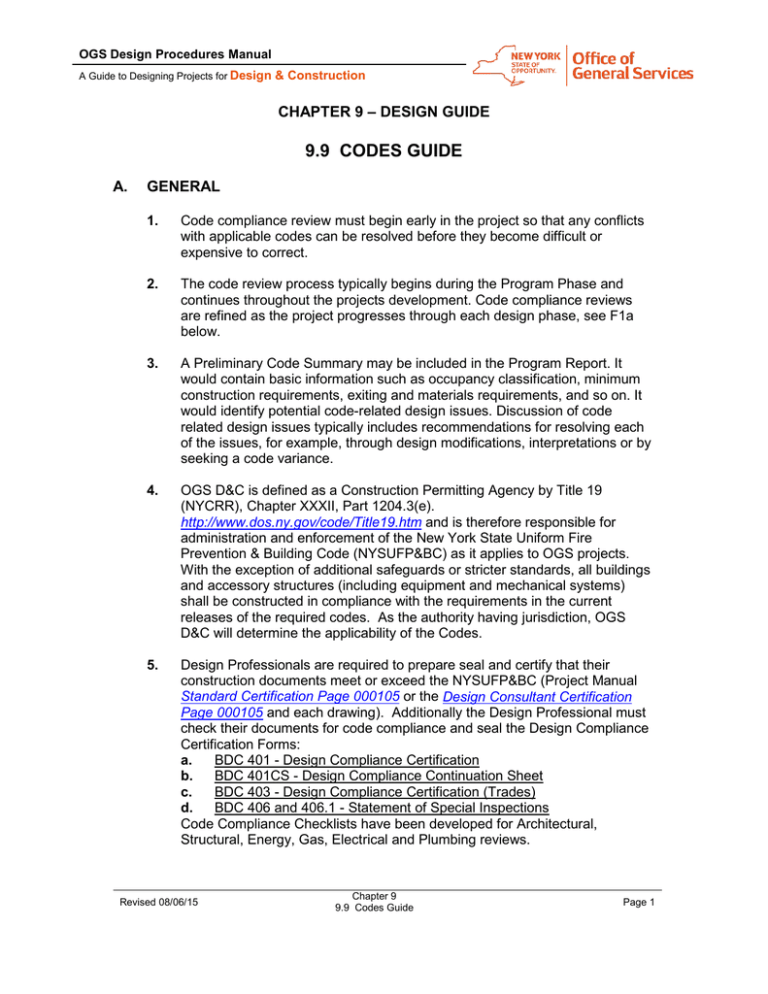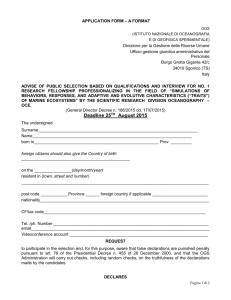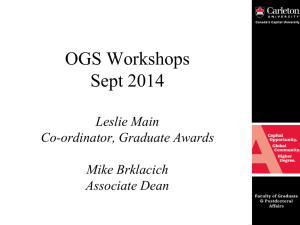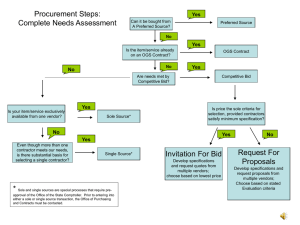Chapter 9.9 Codes Guide - Office of General Services
advertisement

OGS Design Procedures Manual A Guide to Designing Projects for Design & Construction CHAPTER 9 – DESIGN GUIDE 9.9 CODES GUIDE A. GENERAL 1. Code compliance review must begin early in the project so that any conflicts with applicable codes can be resolved before they become difficult or expensive to correct. 2. The code review process typically begins during the Program Phase and continues throughout the projects development. Code compliance reviews are refined as the project progresses through each design phase, see F1a below. 3. A Preliminary Code Summary may be included in the Program Report. It would contain basic information such as occupancy classification, minimum construction requirements, exiting and materials requirements, and so on. It would identify potential code-related design issues. Discussion of code related design issues typically includes recommendations for resolving each of the issues, for example, through design modifications, interpretations or by seeking a code variance. 4. OGS D&C is defined as a Construction Permitting Agency by Title 19 (NYCRR), Chapter XXXII, Part 1204.3(e). http://www.dos.ny.gov/code/Title19.htm and is therefore responsible for administration and enforcement of the New York State Uniform Fire Prevention & Building Code (NYSUFP&BC) as it applies to OGS projects. With the exception of additional safeguards or stricter standards, all buildings and accessory structures (including equipment and mechanical systems) shall be constructed in compliance with the requirements in the current releases of the required codes. As the authority having jurisdiction, OGS D&C will determine the applicability of the Codes. 5. Design Professionals are required to prepare seal and certify that their construction documents meet or exceed the NYSUFP&BC (Project Manual Standard Certification Page 000105 or the Design Consultant Certification Page 000105 and each drawing). Additionally the Design Professional must check their documents for code compliance and seal the Design Compliance Certification Forms: a. BDC 401 - Design Compliance Certification b. BDC 401CS - Design Compliance Continuation Sheet c. BDC 403 - Design Compliance Certification (Trades) d. BDC 406 and 406.1 - Statement of Special Inspections Code Compliance Checklists have been developed for Architectural, Structural, Energy, Gas, Electrical and Plumbing reviews. Revised 08/06/15 Chapter 9 9.9 Codes Guide Page 1 OGS Design Procedures Manual A Guide to Designing Projects for Design B. & Construction REQUIRED CODES 1. Under the NYSUFP&BC, all building Projects must meet or exceed the following codes and applicable reference standards identified: a. Building Code of New York State b. Fire Code of New York State c. New York State Energy Conservation Construction Code d. New York State Labor Department Industrial Code for items relating to people who work in the building such as safety glass, provisions for window washing, cot space for female employees, asbestos abatement, boiler design, etc. e. Mechanical Code of New York State f. Plumbing Code of New York State g. Fuel Gas Code of New York State h. Residential Code of New York State i. ADA: ICC/ANSI A117.1 (Standard on Accessible and Usable Buildings and Facilities), as referenced in the codes above. j. National Electric Code NFPA 70, as referenced in the codes above. 2. Special Inspections a. In addition to regular construction inspections, typically performed on all OGS projects, Section 1704 of the Building Code of New York State requires “Special Inspections” during the construction of specific types of work. Special Inspections are required of the materials, installation, fabrication, erection or placement of components and connections requiring special expertise to ensure compliance with approved construction documents and referenced standards. b. Revised 08/06/15 Special Inspections require the monitoring of the materials and workmanship that are critical to the integrity of the building structure. Section 1704 identifies: construction work which requires special inspections, exceptions to these requirements, and minimum qualifications for special inspectors. A special inspector is a person meeting the minimum qualifications outlined in Table 1704.1 of the Building Code, and approved by the Code Compliance Manager to perform Special Inspections. Special Inspection Procedure: 1) Designer of Record decides if/what Special Inspections are required. Designer of Record completes the BDC 406 for all projects. a) For a project that requires no Special Inspection, only the one page BDC 406 is required. b) For a project that does require Special Inspection, the BDC 406 AND the BDC 406.1 need to be completed. The BDC 406.1 will detail the level of inspection and testing for each construction category requiring special inspection. 2) Designer of Record gives completed BDC 406 (and 406.1 when required) Statement of Special Inspections to the OGS Project Manager OGS PM), who submits copies of the BDC 406 and Chapter 9 9.9 Codes Guide Page 2 OGS Design Procedures Manual A Guide to Designing Projects for Design & Construction 406.1 along with 100% documents to the Constructability Group at the 100% Submission Phase. The OGS PM also files both forms in the Construction Inspection folder. (When project does not require a 100% Submission, OGS PM files the completed BDC 406 and 406.1 in the Construction Inspection folder at Final Submission Phase. If there are no Special Inspections, only a BDC 406 will be placed in the Construction Inspection Folder, and the BDC 406 will NOT be in the Appendix of the Project Manual). 3) After Constructability Review, the OGS Structural Design Group (OGS SDG) within BU2 will review all Construction projects requiring special inspection for scope, to verify all required inspections have been identified, and all listed inspections are required. When the special inspection requirements have been correctly identified, the OGS SDG will create a pdf version of the BDC 406 and 406.1 and insert this into the Specifications folder for printing. 4) When questions arise or modifications are required, the OGS SDG will discuss the project with Designer of Record. Minor revisions can be made at the final documents phase, while major changes will require resubmitting the BDC 406 and 406.1 for 100% Submission. OGS SDG will then file the resubmitted BDC 406 and 406.1 into the Construction Inspection folder and Specifications folder. 5) Designer of Record resubmits the BDC 406 and 406.1 with any revisions that are required at the Final Submission Phase. The Office of Project Control will verify that the BDC 406 and 406.1 is properly filed at Final Submission. The BDC 406 and 406.1 will appear in the appendix of the Project Manual for all projects that require special inspections. 6) Upon award the OGS Area Supervisor uses the BDC 406 and 406.1 to finalize the staffing necessary to perform inspection and testing and submits the inspection assignments to supervisor for approval, with copies sent to the Designer of Record and OGS SDG. 7) During construction phase, the EIC coordinates special inspections and related inspectors including material testing and the related testing agencies. 8) Special Inspectors document inspections using daily reports and provide reports to the EIC on a timely basis. The EIC transmits copies of the Special Inspection Reports to the Designer of Record. Special inspectors shall inform the EIC and the Designer of Record of any non-conformances that are not immediately resolved. 9) Designer of Record is responsible for reviewing all uncorrected non-complying items and for approving the remedial measures to be taken. 10) EIC maintains a file of all inspections and tests. 11) Special Inspectors sign Final Inspection Report stating all work they inspected is in accordance with the contract documents with Revised 08/06/15 Chapter 9 9.9 Codes Guide Page 3 OGS Design Procedures Manual A Guide to Designing Projects for Design 12) 13) 14) 3. C. exceptions as noted. EIC transmits a copy of the Final Inspection Report to the Designer of Record. EIC issues BDC 405 including a list of special inspections completed in the comments section. An EIC may reference from the Comments section, and attach, a copy of a completed BDC 406.1. See Special Inspections Flow Chart for more detailed information. See Special Inspections Roles and Responsibilities for more detailed information. Some building projects must meet or exceed the following codes as applicable: a. Life Safety Code NFPA 101 for OMH and DCS Medical Program b. NYS Hospital Code c. NYS Sanitary Code d. NYS Department of Health e. NYS Department of Environmental Conservation f. American Corrections Association Standards for Adult Correctional Institutions (ACA) AGENCY SPECIFIC STANDARDS 1. D. & Construction See Chapter 9.7 Agency Specific Standards and Requirements for additional code requirements that are required for Client State Agencies. For example, the Department of Corrections and Community Supervision requires projects to comply with American Correctional Association Standards. LOCAL CODES 1. OGS D&C is not obligated to comply with local codes if the project is located on New York State owned land. OGS D&C legal obligation in other arrangements, such as State facilities on leased land, or leased facilities are more restrictive and the Consultant/Designer should comply with any local codes. Despite our lack of legal obligation, project Consultant/Designers should attempt to comply with local codes as well as the NYSUFP&BC. This is especially the case for any item of work which interfaces or connects with local services. 2. For instance, State projects in New York City are not subject to City building codes or inspections. Refer to the Division of Homeland Security and Emergency Services memorandum dated July 9. 2013 regarding building code citations and permits issued by New York City. However, where fire alarm/fire protection systems (the NYC Fire Dept.) or pollution controls (City pollution standards), noise control, and service access may depend on coordination with local codes including sidewalk encroachment and protections. OGS D&C and our Agency Clients wish to aspire to be good neighbors and avoid unnecessary controversy. Contact the OGS Team Leader when in doubt as to which codes to follow for a specific project. Revised 08/06/15 Chapter 9 9.9 Codes Guide Page 4 OGS Design Procedures Manual A Guide to Designing Projects for Design 3. E. & Construction When State facilities are dependent upon local fire department services, it is good practice to have a preliminary review of the design documents with the local fire department so that any potential compliance concerns can be resolved before they impact the design, schedule and budget. This review may include: accessibility of fire equipment, fire hydrant locations and connections, siamese connection types and locations, water flows and pressures, standpipes, etc. Coordinate this review through the OGS Team Leader. CODE INTERPRETATION As the Authority Having Jurisdiction (AHJ), the OGS will provide final interpretation of the Codes on projects permitted by the Agency. The OGS Code Compliance Manager will provide interpretation assistance as requested. Designers should review code issues with the project Team Leader, and Business Unit Leader prior to bringing the question of interpretation to the Code Compliance Manager for concurrence/assistance. Code interpretations are required to go through the Code Compliance Manager. Designers should not contact the Department of State (DOS) for code interpretations for the following reasons: 1. As the Authority Having Jurisdiction (AHJ), the OGS will provide final interpretation of the Codes on projects permitted by the Agency. Designers are to review code issues with the project Team Leader, their Business Unit Leader, and finally with the Codes QIT. The Codes QIT will coordinate with the Code Compliance Manager who will render an interpretation. Designers should not contact the Department of State (DOS) for code interpretations for the following reasons: a. Provide consistency and continuity for all State Agencies. b. Separate decisions made in consultation with DOS may have unanticipated ramifications for prototypical designs or other OGS Client Agency projects / programs. The Code Compliance Manager represents OGS and their Client Agencies on a global level as opposed to the Designer who is mainly focused on an individual project when asking DOS for statewide interpretations. c. OGS reviews the compliance of hundreds of projects each year and prefers to consult DOS when confronted with unique situations. A project, which may be atypical for one Business Unit or Client Agency, may be common ground for another, so the Code Compliance Manager may have a ready interpretation for your “unusual project”. 2. Variance Petition Forms are available through the OGS Code Compliance Manager. OGS office policy is that Designers should not contact DOS for an interpretation or a variance request until the issue is reviewed by the OGS Code Compliance Manager, Business Unit Leaders, OGS Team Leader and the Director of Design. Revised 08/06/15 Chapter 9 9.9 Codes Guide Page 5 OGS Design Procedures Manual A Guide to Designing Projects for Design F. & Construction SUBMISSION GUIDELINES 1. When relevant a preliminary code analysis including Occupancy and Construction Classification, Fire Separation Distance, Fire Areas and Building Accessibility and a list of noteworthy code concerns should be addressed with possible solutions in the Program Report. The Code Compliance Manager requires the following to be completed as indicated. a. At the first post Program Report submission and updated in each future submission: BDC 402 – 2010 Code Compliance Review Checklist (This document should be reviewed with OGS Team Leaders at the start of a project and at the subsequent submission milestones). b. At the 100% and Final submissions: Completed BDC 406 and 406.1 - Statement of Special Inspections Code Information to be included on the construction drawings: 1) Building Information: Occupancy Classification Construction Classification Building Areas and Fire Areas Sprinkler Status: Required by Fire Area or Occupancy Key Plan with building sides accessible and setbacks 2) Egress Information: Room Use Designations Room Square Footages Room Occupancy Loads Room Exit & Corridor exit width Calculations Exit Travel Distances incl. Common Path Stair & Exit Door exit width Calculations Accessibility for New and Existing Building Areas Corridor/Exit Enclosures - Hourly Ratings Hardware descriptions Structural Design Loads 3) Conventional light-frame construction: Floor and roof live loads Ground snow load Basic wind speed (3-second gust), miles per hour and wind exposure Seismic Design Category and Site Class Floor live load Roof live load Roof snow load Wind load Earthquake design data Flood load Special loads System and components requiring special inspections for seismic resistance Soil classification & design load bearing capacity Revised 08/06/15 Chapter 9 9.9 Codes Guide Page 6 OGS Design Procedures Manual A Guide to Designing Projects for Design & Construction Energy Code Analysis COMcheck results for Construction Insulation and Mechanical and Electrical Consumption Software available on DOS Website www.energycodes.gov/ G. PERMITS 1. Construction permits are required by State Agencies for erection, construction, enlargement, alteration, improvement, relocation, removal, or demolition of any building or structure. This includes, agricultural buildings (EXCEPTION: Agricultural buildings, including barns, sheds, poultry houses and other buildings and equipment on the premises used directly and solely for agricultural purposes), greenhouses, retaining walls – where their failure affects an adjacent occupied or habitable structure, sheds, tanks – essential to building services (water, heating fuel, fuel for a required emergency generator) or where their failure affects an adjacent occupied or habitable structure, towers – essential to building services (power) or where their failure affects an adjacent occupied or habitable structure, and reroofing projects. Construction permits are required for all project types (Including: Standard, Unit Price, Work Order, M, Q, Cost Plus, Sole Source, Inmate Labor and Job Order Contracts.) Work which does not require a Construction Permit shall be processed with a BDC 401.1 – Waiver of Construction Permit. Work exempt from the requirement for a Construction Permit is still required to be designed and constructed ‘code compliant’. For assistance with identifying if a BDC 401.1 may be used for a project, instead of the BDC 401 – Design Compliance Certification, please review BDC 401.1 – Instructions and Waiver of Construction Permit. If additional assistance is required, review the project with the Team Leader and Business Unit Leader, prior to contacting the Code Compliance Manager. Permits are not required for repairs that do not materially affect structural elements and/or the plumbing, electrical, heating/ventilation, or Fire Alarm / Fire Protection systems; or for the construction of storage facilities of less than 3000 cubic feet; or for work costing $20,000 or less on an EXISTING building. Construction Permits are not issued for: Emergency projects (in accordance with paragraph 7 below). Roof repair (not replacement) projects, Outdoor earthwork projects (buried piping, manholes, paving, landscaping, etc.), unless the work extends into buildings or affects building systems. 2. Construction permits for “Demolition” work requires compliance with the following: a. Chapter 9.13 Demolition of Structures Guide of the Design Manual b. Chapter 33 of the Building Code of New York State c. Chapter 14 of the Fire Code of New York State d. The OGS documents; BDC 401 – Design Compliance Certification, and BDC 403 – Design Compliance Certification (trades) as appropriate Revised 08/06/15 Chapter 9 9.9 Codes Guide Page 7 OGS Design Procedures Manual A Guide to Designing Projects for Design H. & Construction 3. State Agencies seeking a construction permit must submit the following information: a. Description of the site upon which the proposed work is to be done. b. Description of the use or occupancy of all parts of the land and of the proposed building or structure. c. Where work is proposed for an existing structure, a description of the current use or occupancy of the structure. d. Description of the work proposed to be undertaken. e. The name(s) of the State agency which will have custody of the structure during construction and after the project is completed. f. Complete set of plans and specifications for the proposed project. 4. The Code Compliance Manager may waive the requirement for plans and specifications where the work to be performed is an Emergency project, involves minor alterations, or where the Code Compliance Manager determines that plans and specifications are unnecessary. 5. Applicant agencies are required to notify the permit issuing agency if the information contained on the permit application changes. Permit will not be issued if the proposed work does not comply with the NYSUFP&BC. 6. Construction permits may be rescinded if the work does not proceed in conformance with the applicable codes or attached conditions or if errors are discovered in the permit application. 7. State Agencies may undertake emergency repairs or reconstruction work without a Construction Permit. Emergency projects are limited to $200,000 and are administered through the Division of Construction. Emergency projects are initiated with the issuance of a BDC 318 – Declaration of Emergency from the Client Agency. This work must still comply with all applicable codes. A Code Compliance Certificate, and supporting documentation, may still be required. 8. The Division of Construction requires and will complete BDC 405 – Construction Compliance Certification for all projects permitted and emergency projects. BDC 215 – Code Compliance Certificate is required when these projects are completed. TOOLS AND RESOURCES 1. Construction Permit Document Review Checklist, BDC 402.1 a. Under Title 19 NYCRR, a State Agency Code Compliance Manager is responsible for “providing for” the review of requests for a Construction Permit. To provide documentation that this requirement has been satisfied as part of the permit process, all projects which require a BDC 401, Design Compliance Certification, must include a sign off for Permit Issuance Recommendation. The Permit Issuance Recommendation Revised 08/06/15 Chapter 9 9.9 Codes Guide Page 8 OGS Design Procedures Manual A Guide to Designing Projects for Design b. c. d. & Construction can be found at the bottom of the BDC 401, and is to be signed by the OGS employee who can identify that the review was performed. The person performing the review is not required to be licensed or certified as a Code Enforcement Official (CEO), by the NYS DOS, they must have a good working knowledge of the issues they are reviewing, and must not be the Designer of Record. The OGS employee signing the Permit Issuance Recommendation must be a licensed RA, PE, or Certified CEO, and must not be the Designer of Record. The BDC 402.1, Construction Permit Document Review Checklist, was developed as a guide to assist in a document review, and establishes a baseline for this process. It is always an option for a reviewer to exceed this minimum guideline. It is suggested that a hard copy of this completed checklist be maintained in the project folder, for future reference. 2. The Department of State Code Clarifications is available on their web site at the following link. http://www.dos.ny.gov/code/pdf/jan03clarif.pdf 3. OGS Code Bulletins are a product of code determinations by the Code Compliance Manager. These interpretations govern work under the direction of the OGS. It is the intent of these documents to provide direction to design teams and field staff on determinations made regarding these interpretations. Code Bulletins can be found on DCNet under: D&C Reference / Building Codes and Standards / OGS Code Bulletins. To understand the filing system for these bulletins, view the ‘INSTRUCTIONS file first. 4. ICC Code Opinions http://www.iccsafe.org (An exclusive benefit of ICC Membership) a. There are two types of code opinions: staff opinions and committee interpretations. However, these opinions and interpretations do not include the New York State code enhancements. The ICC Code Committee interpretations will be carefully considered but the OGS Code Compliance Manager is the authority having jurisdiction. b. Staff Opinions: Staff opinions are the opinions of the staff and do not represent the official position of the International Code Council, nor do they represent the views of any enforcing agency. The enforcing agency is the only agency that has the authority to render interpretations of the code. c. Staff code opinions may be either verbal or written. When requesting a staff code opinion you must include your ICC membership number. d. Committee Interpretations: Committee Interpretations are intended to provide technical support and clarification of code text for adopting jurisdictions, design professionals, and members of the construction industry. Committee Interpretations are processed in accordance with ICC Policy CP #11, Committee Interpretations on International Code Revised 08/06/15 Chapter 9 9.9 Codes Guide Page 9 OGS Design Procedures Manual A Guide to Designing Projects for Design e. 5. & Construction Provisions. Committee Interpretations approved by the Interpretation Committee represent the official position of the International Code Council; however, the final interpretation is the responsibility of the code official having jurisdiction. ICC Code Opinions and Interpretations are not the official opinions or interpretations of the NYS Department of State, or of the Authority Having Jurisdiction, and are to be used for guidance ONLY. The ICC publishes Code Commentary, Code Interpretation and other Code Handbooks that are available to Designers at http://www.iccsafe.org. These publications do not include the New York State code enhancements. Note: These publications will be available to OGS Designers in electronic CD and handbook form the near future. 6. COMcheck Software available on DOS Website www.energycodes.gov/ 7. New York City Codes web links: a. The entire NYC building code, including elevators is online at: http://www.nyc.gov/html/dob/html/codes_and_reference_materials/reference.shtml b. The NYC noise code can be found at: http://www.nonoise.org/lawlib/cities/newyork.htm c. The NYC Pollution Code, located in the city’s Administrative Code Title 24, Chapter 1, can be purchased either hard copy or in electronic format, a subscription update service is available in either format. d. The NYC amendments to the NEC can be found at: http://home2.nyc.gov/html/dob/downloads/pdf/nec_20052002_change_comparison.pdf I. ADDITIONAL INFORMATION 1. Contact the OGS Codes Quality Improvement Team for additional information or assistance. Revision History: Rev Date 0 04/23/13 Last revised date 1 12/02/13 Local codes NYC memorandum reference 2 08/06/15 Page 3 Changed BU5 to BU2 Revised 08/06/15 Description Chapter 9 9.9 Codes Guide Reviewed by: Approved by: C. Parnett D. Dostie Parnett Parnett Page 10




